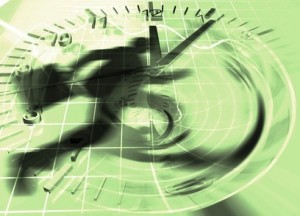 Would you like to be able to quickly determine where synergies and problems exist in an organization? Come along to see how knowing individuals’ temperaments can help predict possible outcomes in team situations.
Would you like to be able to quickly determine where synergies and problems exist in an organization? Come along to see how knowing individuals’ temperaments can help predict possible outcomes in team situations.
Traits
Temperament refers to preferred ways of thinking. Traits refer to preferred behaviors. They correlate well. Let’s look at a mythical company with the following temperament mix:
- CEO – NT (intuitive thinker)
- Senior staff member – NF (intuitive feeler)
- Operations manager – SJ (sensing judger)
- Programmer – SP (sensing perceiver)
Of course, none of them want their time wasted. The problem is with their perception of time. Here is the order in which they each prioritize past, present, and future. Also, their nicknames have been included to give a hint as to where their priorities lie.
TRAIT Nickname Past Present Future
NT Field Marshal 2 3 1
NF Organizer 3 1 2
SJ Enforcer — 1 —
SP Doer 1 2 3
So how does this play out in the work place? Take a look at each of their POSITIVE traits…
NT (Field Marshal)
- Sees where the company can be in the future
- Sets standards and holds to them
- Delegates today’s activities to others
- Strategic thinker
- Holds on to the vision throughout difficulties
- Leads the way and doesn’t waver
- Main interest is achieving dreams and accomplishments
- The past informs the future. Incorporates lessons-learned into future plans
NF (Organizer)
- Takes interest in others and how they are brought together to get things done
- Pays attention to the overall-balance among key factors
- Puts “teeth” into the NT’s strategic plans
- Will look towards the future by focusing on generating cooperation today
- Works as a shock absorber between the NT and lower ranks
SJ (Enforcer)
- Focuses on NOW
- Stays on task and gets things done
- Knows the limits of available resources
- Tactically-oriented
- Supports the strategies that come down from above
SP (Doer)
- Prefers a structure be presented within which work can be performed
- Wants to know what the orders are for getting work done
- Prefers others develop strategies
- Wants involved when tasks are defined
As you have probably guessed by now, there can be a dark side to all this. Now, let’s take a peek at some of their more… ahem… challenging aspects…
NT (Field Marshal)
- Doesn’t hesitate to change on-going work in order to leverage the future
- Believes the project is complete at the moment of delegation
- Does not want to be distracted by problems from the present
- Risk management is for nay-sayers. It can distract from the future
- Positive criticism downplayed or ignored
- Negative criticism emphasized
- Little interest in people and their requirements
- Can ride roughshod over others and have a short memory regarding those behaviors
NF (Organizer)
- Can lose sight of the need to mend problems from the past since there is push for today and the future.
SJ (Enforcer)
- Rules are to be enforced, not questioned
- The past can’t be fixed and the future is out of reach so don’t waste time on either of them
- Finds strategizing, planning, and spending time on what-ifs boring
- Wonders if strategies are sane
SP (Doer)
- Wonders if the plan is sane
- Can be rebellious yet wants no risk
- Can go in own direction without informing others
- Gauges work and others based on how the SP was treated in the past
- Change is viewed with suspicion. The past needs to be resolved
The Leadership Challenge
You can see that avoiding wasting time can quickly turn into a multi-dimensional problem! Making the effort to understand others can pay huge dividends by providing clear vision as to strengths and limits in various situations with your team. With that understanding as a base, planning and execution can proceed realistically.
Are any of these traits familiar to you from team projects you’ve worked on? How about in your family?
Gary Monti has over 30 years experience providing change- and project management services internationally. He works at the nexus between strategy, business case, project-, process-, and people management. Service modalities include consulting, teaching, mentoring, and speaking. Credentials include PMP number 14 (Project Management Institute®), Myers-Briggs Type Indicator certification, and accreditation in the Cynefin methodology. Gary can be reached at gary.monti@aureliuspress.com.
If you’d like to submit a Jungian-focused blog on working with different personality types (in professional or personal settings), please contact Jennifer Rojas, our Blog Editor, at jennifer.rojas@aureliuspress.com.
